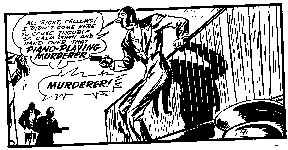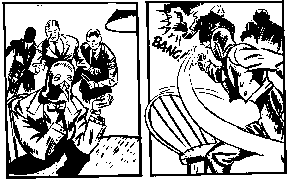|
Who is the Penguin? <--Back
One of the more obscure, but better heroes to come out of the Canada Whites days of the early 1940s was the mysterious, fleet footed detective known as the Penguin. If the name doesn't strike fear into your heart, you're excused. The Penguin created by the "Jack Kirby of Canadian Comics", Adrian Dingle, first kicked bad guy ass in Wow Comics No. 15 (November 1943). With supporting characters such as the lovely Cherry Dawn and the friendly, albeit inept, American friend Simon Snurge, the Penguin's boot stomp of crime didn't stop until three years later when the flashier American super heroes like Batman, Superman and Captain America were once again allowed over our borders impressing the four colour starved children. Back in the early days of the Canada Whites, studios were turning out hundreds of characters annually in hopes that at least one could match the popularity of the American heroes. With such a glut of heroes, good names were hard to come by, hence the Penguin and other faux pas monikers such as Whiz Wallace, Hugh Dunnit or Polka-Dot, Lady Pirate. After you get past the nearly unpalatable names you discover heroes every way the superior to the American heroes, including Batman. The Penguin serial enjoyed its short tenure of success due to Dingle's plot innovations, tight story telling, fluid drawings and wry wit. Although some stories were outlandish the majority were well within the realms of good taste.
The Penguin didn't wear the standard issue attire of spandex togs with a lame chest emblem, instead he devoted his fight against crime wearing an expensive tuxedo and his face concealed by a mask resembling a droopy-eyed penguin. At least he never wore red underwear over blue long johns with a red cape tied around his neck. Dingle went to great lengths to keeping the identity of the Penguin a shrouded mystery by heavy use of shadows, scarves and sun glasses. Eventually with Wow Comics No. 30, the beaked cowl came off and the Penguin was revealed as Bruce Baron, an affluent neo-socialite.
As an afterward, the Penguin had a full colour resurrection in Slam Bang Comics (November 1946) as the Blue Raven, Glamour Boy of '46. Continuity was seemingly thrown out and the only thing that remained the same was tux and the droopy-eyed penguin mask. That was the Penguin's last appearance – identity unresolved. Over 50 years later the question remains "Who is the Penguin?"
|

 Like all good detectives of the era, Dingle's creation was armed with the inductive and deductive skills of Sherlock Holmes, the walloping right hook of Jersey Joe Wilcott and the aim of William Tell. However like most heroes of the Penguin's day, he wasn't intent on whirligig gadgets or other gimmick. If his physical prowess couldn't get him out of a jam, then he'd have to out smart his captors, instead of relying on his boy ward, the gender alternatives of Penguin Woman and Penguin Girl or even a Penguin Mite. Simply put, the Penguin was self sufficient and didn't rely on gimmicks.
Like all good detectives of the era, Dingle's creation was armed with the inductive and deductive skills of Sherlock Holmes, the walloping right hook of Jersey Joe Wilcott and the aim of William Tell. However like most heroes of the Penguin's day, he wasn't intent on whirligig gadgets or other gimmick. If his physical prowess couldn't get him out of a jam, then he'd have to out smart his captors, instead of relying on his boy ward, the gender alternatives of Penguin Woman and Penguin Girl or even a Penguin Mite. Simply put, the Penguin was self sufficient and didn't rely on gimmicks. Many young fans were disappointed, feeling that they had been duped by Dingle's red herrings as to the Penguin's true identity. Readers felt Baron couldn't possibly be the Penguin and this was another ploy of Dingle's to throw cluemasters off the trail. Much to the chagrin of many, the old bird's strip came to an end before fans could get a definitive resolution.
Many young fans were disappointed, feeling that they had been duped by Dingle's red herrings as to the Penguin's true identity. Readers felt Baron couldn't possibly be the Penguin and this was another ploy of Dingle's to throw cluemasters off the trail. Much to the chagrin of many, the old bird's strip came to an end before fans could get a definitive resolution.